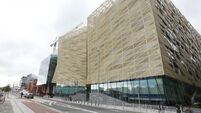My Job: Mapping out Cork's transport network

Jacobs' senior vice president Kate Kenny: 'Cork is a vibrant, growing city, a location that is hugely attractive for investment and as a place to live and work.'
As the population of Cork continues to grow, so too does the infrastructure needed to support this social and commercial expansion.
Selected by the National Transport Authority as consultants for the BusConnects Cork Sustainable Transport Corridors programme, the scope of work undertaken by Jacobs includes preparation of the Environmental Impact Assessment report, in addition to the construction strategy and transport assessment.
The BusConnects Cork programme aims to provide better walking, cycling, and bus infrastructure for 11 key access corridors in the Cork region, enabling greater mobility and preparation for future demand.
“BusConnects Cork is focused on fundamentally transforming Cork's bus and active travel system, so it becomes a viable and attractive choice for commuters and visitors — improving the quality of life for the community while supporting the economy and the environment,” explains senior vice president Kate Kenny.
Jacobs is also supporting the planning process for the NTA's BusConnects Dublin programme. “We are harnessing our advisory and digital capabilities to drive innovation and help clients like the NTA create responsive and efficient transportation systems tailored to users’ needs.” She adds that the project is particularly close to her heart, as she’s married to a Cork man, and visits family in the city regularly.
The recently opened Dunkettle Interchange marked another significant milestone in enhancing transportation infrastructure and connectivity in Cork.

This major €215m reconfiguration project has created a signal-free junction between the strategically important M8, N25 and N40 to the east of the city, and promises to alleviate congestion and streamline traffic flow for the region’s residents and businesses.
With traffic volumes through the interchange up to 120,000 vehicles on weekdays, Transport Infrastructure Ireland reports that journey times during peak hours have reduced by an average of 50% as a result of this upgrade project. “Cork is a vibrant, growing city, a location that is hugely attractive for investment and as a place to live and work. Infrastructure projects like the Dunkettle Interchange upgrade are critical to contribute positively to the quality of life for the community, sustain economic development, and continue to ensure Cork’s position as a thriving city.”
Jacobs has more than 1,200 employees in Ireland serving clients in a variety of sectors, including advanced manufacturing, transport planning, energy and power, and environment. Kate Kenny leads a workforce of over 8,000 people and is responsible for driving growth within the company’s Buildings and Infrastructure portfolio across Europe. “We take an integrated approach, delivering digitally-enabled technology solutions and results that transform lives — for our clients and our communities, to help make the world smarter, more connected, and more sustainable.”
With 20 years of experience in engineering consultancy, Kate has worked on the business cases for major UK infrastructure programmes, including Crossrail, High-Speed Two, the expansion of Heathrow and Stansted airports and the Silvertown Tunnel in London.
Following her A-levels, Kate went to Royal Holloway, University of London, studying Pure Maths. After graduation, she worked for a time in clubs and pubs around Brighton — an experience of life that proved valuable in later years. “Perhaps it was not an obvious career step for a mathematician, but it was great fun. I loved being customer-facing and it gave me a great grounding in working with diverse people and handling difficult situations.”
Eventually accepting a job as a graduate transport consultant with a large engineering firm, she worked on a wide variety of projects, including analysis of the implementation of London’s congestion charging scheme and European cross-border traffic data exchange. “It is a diverse occupation where no two days are the same. I learn something new every day and am lucky to work with incredibly talented people.”
A Fellow of the Institution of Civil Engineers and an active industry mentor, she is an advocate for supporting young women on the impact they can have on the world by taking a path in engineering and technology. “It is important that women trust in their ability to grow and develop organically in their careers, and are supported to build confidence, as well as competence, along the way. These careers really are about the infinite ways we can do things better, and we need diverse talent to support that.”
She cites ‘interdisciplinary’ as key to many solutions: “We intentionally put multiple disciplines around a client problem, to provide diversity of thought and help us find the best range of solutions.”
After winning the prestigious ‘Inspirational Woman of the Year’ at the Women in Rail Awards 2023, given to outstanding individuals who have shown exceptional leadership and dedication, she said: “I am very grateful to those who have paved the way for inclusion and diversity in our industry, which has opened up possibilities for me and many others. If this award goes any way towards encouraging more people to break barriers and achieve their full potential, I will be absolutely thrilled. This award is less about me, and more of a reflection of all of you.”
The role of the city in a post-pandemic world is under the spotlight, she says, grappling with questions related to the future of central business districts now that remote working has become more accepted. “The pandemic has allowed us to peel back the skin of cities, to create a better understanding of the systems that keep our society and economy going, and the fragility of these systems. When we talk about ‘recovery’, we are often discussing rebounding from the short sharp shock of covid-19, when in fact we need to be paying attention to some of the systemic problems that it has brought under the spotlight.”
If done properly, we should be looking at creating a future where cities are more resilient to shocks, with a less devastating impact. “Despite what we have experienced and the recovery challenge ahead of us, the climate emergency is still arguably the biggest challenge our cities face. The pandemic has helped us see what good looks like in terms of air quality and active travel. We are at a point where we need to build upon these short-term improvements and turn them into long-term ways of life.”
A collection of the latest business articles and business analysis from Cork.













